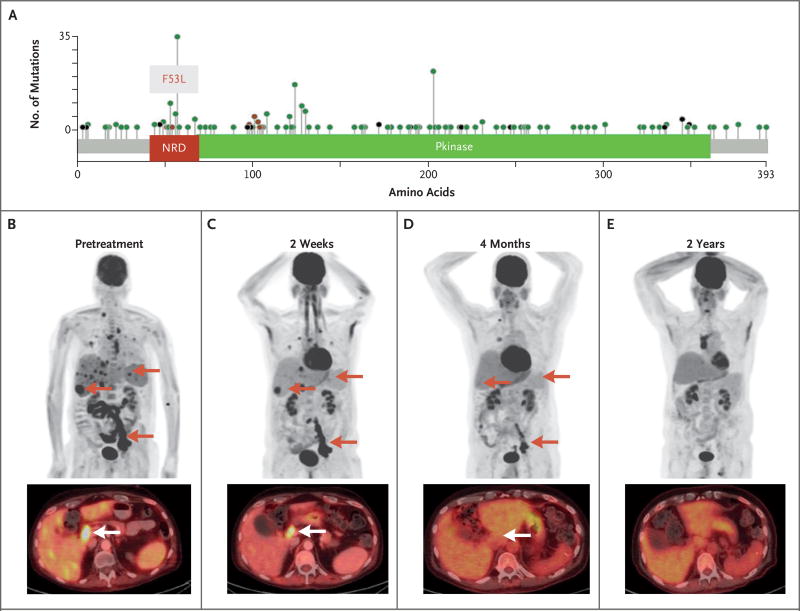To the Editor
A high prevalence of BRAF V600E mutations are detected in patients with Langerhans’-cell histiocytosis and Erdheim–Chester disease, which is a subset of non–Langerhans’-cell histiocytosis. Vemurafenib, a BRAF inhibitor, has shown sustained efficacy in patients with Langerhans’-cell histiocytosis and Erdheim–Chester disease.1 Oncogenic mutations in BRAF and mitogen-activated protein kinase (MAPK) are mutually exclusive and may be mechanisms by which the RAF–MEK–ERK pathway is activated in histiocytic neoplasms.2
Histiocytic sarcoma, a subset of non–Langerhans’-cell histiocytosis, is a rare, aggressive, and poorly understood disease associated with a median overall survival of 6 months. Since disease-specific therapies are lacking, systemic treatments include regimens for non-Hodgkin’s lymphoma or sarcoma.3,4 Patients with histiocytic sarcoma and BRAF V600E mutations have been reported to have a response to vemurafenib. We describe a patient who had histiocytic sarcoma with an activating mutation in MAP2K1 who had a complete clinical response and a response on imaging to trametinib, a MAPK kinase (MEK) 1 and 2 inhibitor
A 62-year-old man with a history of untreated grade 1 or grade 2 follicular lymphoma (BCL2 rearranged) presented with a new onset of fatigue, persistent fever (temperature, 39°C), and night sweats. Combined positron-emission tomography and computed tomography (PET–CT) showed hypermetabolic visceral, nodal, and osseous lesions suggestive of a high-grade transformation of follicular lymphoma (Fig. 1B). Treatment with rituximab and bendamustine was ineffective. He underwent a biopsy, which revealed pleomorphic cells that were positive for CD4, CD11c, CD33, and lysozyme; these findings were consistent with histiocytic sarcoma and raised the possibility of transdifferentiation from follicular lymphoma. The patient had a minimal response to doxorubicin and cyclophosphamide, and these drugs had toxic effects.
Figure 1. Mutations in MAP2K1 across many Tumor Types and Pretreatment and Posttreatment Imaging in the Patient.
The MAP2K1 (MEK1) protein structure as well as mutations seen in the negative regulatory domain (NRD) and the protein kinase domain (Pkinase) are shown (Panel A). Locations of mutations and domains in proteins are shown by lollipop structures, with the mutation type indicated by color. Protein domains are also distinguished by color. Red denotes in-frame, black truncating, and green missense mutations. Maximum intensity projection (MIP) coronal and axial fused images from combined positron-emission tomography and computed tomography (PET–CT) with 18F-fluorodeoxyglucose (FDG) before treatment show splenomegaly and widespread hypermetabolic lesions (red and white arrows) in the liver (maximum standardized uptake value [SUV], 9.8), spleen, lungs, and pelvic nodes (Panel B). Images obtained 2 weeks after the initiation of trametinib show interval resolution of splenomegaly and a decrease in the number, size, and metabolism of lesions in the liver (maximum SUV, 5.9), spleen, lungs, and pelvic nodes (Panel C). Images obtained 4 months after treatment show further response to treatment, with resolution of multiple lesions and a decrease in the size and 18F-FDG avidity of the residual sites of disease. A lesion in the liver had a maximum SUV of 3.4 (Panel D). Coronal MIP and an axial PET–CT fused image after 2 years of treatment show a complete response to treatment, with no evidence of FDG neoplastic disease (Panel E); the foci of intense FDG activity uptake in the mediastinum correspond with biopsy-proven aspergillus infection, and the foci of intense FDG activity uptake in the left groin correspond to benign inflammation. Images courtesy of Dr. Lorenzo Mannelli, Department of Radiology, Memorial Sloan Kettering Cancer Center.
The patient provided consent to undergo a next-generation sequencing test that revealed somatic mutations in BCL10, BCL2, CDKN1B, KIT, and MAP2K1-F53L. MAP2K1-F53L (159T→A) has been reported in melanoma; lung, colon, and gastric cancer; and hairy-cell leukemia (Fig. 1A). Substitution of leucine for phenylalanine in the negative regulatory domain of MAP2K1 results in a conformational shift that exposes the catalytic ATP-binding pocket and results in constitutive kinase activity.5
Since clinical trials of trametinib were lacking, the patient provided consent to receive off-label trametinib at a dose of 2 mg daily. Three days after the initiation of trametinib, he had resolution of all B symptoms, including weight loss, fatigue, and fever, and reduced leukocytosis, thrombocytosis, and anemia. PET–CT (Fig. 1C through 1E) showed a rapid and durable complete response that continued for more than 2 years.
These results are consistent with preclinical findings of MAP2K1 mutations as an alternative mechanism for activating the MAPK pathway in histiocytic neoplasms. Like other types of non–Langerhans’-cell histiocytosis, histiocytic sarcoma (sporadic or transformed) may harbor mutations in the MAPK pathway, and tumor profiling may be helpful. Basket studies of MEK or ERK inhibitors in cancers harboring MAP2K1 mutations may be warranted.
Acknowledgments
Supported by a Memorial Sloan Kettering Cancer Center core grant (P30 CA008748) and the Draper Family Fund.
Footnotes
Disclosure forms provided by the authors are available with the full text of this article at NEJM.org.
References
- 1.Hyman DM, Puzanov I, Subbiah V, et al. Vemurafenib in multiple nonmelanoma cancers with BRAF V600 mutations. N Engl J Med. 2015;373:726–36. doi: 10.1056/NEJMoa1502309. [DOI] [PMC free article] [PubMed] [Google Scholar]
- 2.Diamond EL, Durham BH, Haroche J, et al. Diverse and targetable kinase alterations drive histiocytic neoplasms. Cancer Discov. 2016;6:154–65. doi: 10.1158/2159-8290.CD-15-0913. [DOI] [PMC free article] [PubMed] [Google Scholar]
- 3.Gounder M, Desai V, Kuk D, et al. Impact of surgery, radiation and systemic therapy on the outcomes of patients with dendritic cell and histiocytic sarcomas. Eur J Cancer. 2015;51:2413–22. doi: 10.1016/j.ejca.2015.06.109. [DOI] [PMC free article] [PubMed] [Google Scholar]
- 4.Kommalapati A, Tella SH, Durkin M, Go RS, Goyal G. Histiocytic sarcoma: a population-based analysis of incidence, demographic disparities, and long-term outcomes. Blood. 2018;131:265–8. doi: 10.1182/blood-2017-10-812495. [DOI] [PMC free article] [PubMed] [Google Scholar]
- 5.Arcila ME, Drilon A, Sylvester BE, et al. MAP2K1 (MEK1) mutations define a distinct subset of lung adenocarcinoma associated with smoking. Clin Cancer Res. 2015;21:1935–43. doi: 10.1158/1078-0432.CCR-14-2124. [DOI] [PMC free article] [PubMed] [Google Scholar]



